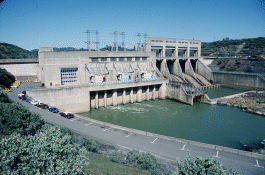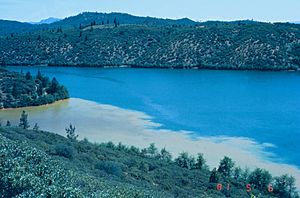Keswick Dam facts for kids
Quick facts for kids Keswick Dam |
|
|---|---|
 |
|
| Country | United States |
| Location | Shasta County, California |
| Coordinates | 40°36′43″N 122°26′45″W / 40.61194°N 122.44583°W |
| Construction began | 1941 |
| Opening date | 1950 |
| Owner(s) | U.S. Bureau of Reclamation |
| Dam and spillways | |
| Type of dam | Concrete gravity |
| Impounds | Sacramento River |
| Height | 157 ft (48 m) |
| Length | 596 ft (182 m) |
| Dam volume | 214,000 cu yd (164,000 m3) |
| Spillways | Gated overflow |
| Spillway capacity | 250,000 cu ft/s (7,100 m3/s) |
| Reservoir | |
| Creates | Keswick Reservoir |
| Total capacity | 23,800 acre⋅ft (29,400,000 m3) |
| Catchment area | 6,380 sq mi (16,500 km2) |
| Normal elevation | 601.6 ft (183.4 m) |
| Power station | |
| Turbines | 3 |
| Installed capacity | 117 MW |
| Annual generation | 416,585,000 KWh (2001–2012) |
The Keswick Dam is a large concrete dam on the Sacramento River in California. It is located about 2 miles (3.2 km) northwest of Redding. This dam is part of a bigger plan called the Central Valley Project.
The Keswick Dam is 157 feet (48 m) tall. It holds back water to create the Keswick Reservoir. This reservoir can hold a lot of water, about 23,800 acre-feet (29.4 million cubic meters). The dam also has a power plant with three big machines called turbines. These turbines can make 117 megawatts (MW) of electricity. That's enough power for many homes!
The dam and its reservoir act like a "forebay" for the Shasta Dam upstream. A forebay is like a small holding pond. It helps control the water released from Shasta Dam's power plant. This makes sure the water flow is steady. The electricity from Keswick Dam also helps power other areas. It connects to power plants at Trinity Dam and Lewiston Dam. It also connects to the Judge Francis Carr Power Plant and the Spring Creek Power Plant.
Contents
Why Was Keswick Dam Built?
Water Challenges in California
California faced big water problems starting in the 1800s. This was during the Gold Rush era. Many people came to California to find gold. After a while, many of them started farming instead. The Central Valley had rich soil and plenty of water. It was also flat, which was great for growing crops. As more people moved in, the demand for food grew. This led to bigger farms.
However, the weather caused problems. In winter, heavy rains led to floods. But in summer, there were often severe droughts. When water levels were low, salt from the ocean could move into the river. This made some parts of the valley and San Francisco Bay salty.
At first, the Keswick Dam project was mainly for irrigation. This means providing water for farms. But it became a "multipurpose" project. This means it served many needs. It helped control floods and made the Sacramento River easier to navigate. It also supplied water for homes and businesses. Plus, it made electricity, helped fish and wildlife, and created places for fun activities. It even improved water quality.
The Central Valley Project
The Keswick Dam is a key part of the Central Valley Project (CVP). This huge project was created to solve California's water problems. Some landowners had no water, especially in hot, dry summers. The CVP aimed to share water fairly.
The Central Valley Project covers a vast area. It stretches from the Cascade Range mountains in the north to the fertile plains in the south. California's government started the CVP in 1933. But the U.S. government took over the project later. Funds for the first parts of the CVP came from a special law in 1935.
Later, the U.S. Bureau of Reclamation took charge of the CVP. The project had three main goals:
- To control rivers and prevent floods.
- To provide water for farms and homes.
- To generate electricity.
Over time, more canals, power plants, and dams were built. The CVP became very important for managing water in the region. Keswick Dam is part of the CVP's Shasta Division, which also includes Shasta Dam. Keswick Reservoir helps stabilize the water flow from Shasta Dam. It also collects water from the Trinity River.
Building the Dam
Construction Challenges
Keswick Dam was named after Lord Keswick. He was the president of a mining company. Construction began in August 1941. The U.S. Bureau of Reclamation hired Guy F. Atkinson and Kiefer Construction companies.
Building the dam was not easy. There was a shortage of workers. This was due to other problems in the Central Valley. The weather also caused issues. In hot summers, workers had to spray water to cool the building materials. In winter, they heated mixtures to keep them warm. During rainy seasons, construction had to stop because of floods.
Near the end of World War II, workers went on strike for about a month in 1944. They wanted higher wages. The workers returned after a promise from the War Labor Board. The board later increased their wages.
Completing the Dam
In December 1947, there wasn't enough money to finish the dam as planned. However, the powerhouse structure was completed. By July 1948, the spillway was finished. The spillway is a channel that lets excess water flow out.
In 1949, two generators were installed at the Keswick power plant. The dam's gates started working on February 20, 1950. The last generator was installed on March 31, 1950. The dam was officially open in 1950.
The Area Around Keswick Dam
Landscape and Climate
The land around Keswick Dam is very interesting. It has features from three different areas: the Klamath Mountains, the Cascade Range, and the Central Valley. You can see pine and oak forests, along with rocky areas. The nearby city of Redding, California, is built on volcanic and sedimentary rocks. You can also see two volcanoes, Mount Shasta and Lassen Peak, from many spots.
The Keswick Reservoir's water level can change quickly. It gets water from Shasta Dam. Then, it sends water to Keswick Dam's power generators. It also sends water to meet demands downstream.
The climate in Shasta County is hot and dry in summer. It is cool and wet in winter. Spring and fall have the best weather. The area gets about 69 inches (175 cm) of rain each year. Most of the rain falls from October to March. From June to September, there is very little rain. Summer temperatures are usually around 85 to 90°F (29 to 32°C). Winter temperatures average about 40°F (4°C).
In summer, more water is released from the dam. This is because more water is needed, especially for farms. High temperatures also cause more water to evaporate. So, more water is needed to help crops grow.
Water Flow and Quality
Keswick and Shasta dams work together to control the flow of the Sacramento River. In summer, even during dry months, Shasta Dam releases a lot of water. This greatly increases the water flowing into Keswick. Water from Whiskeytown Dam and Clear Creek Reservoir also flows into the Sacramento River through Keswick Reservoir. This water helps meet the needs of Southern California.
The riverbed below Keswick Dam has coarse gravel in some places. In other places, it has fine sediments.
The Iron Mountain Mine was a very active mine nearby. It produced valuable metals. But it also caused a big problem: acidic water. This water carried contaminated sediments into the Sacramento River. The mine was next to Keswick Reservoir. It was the biggest source of toxic metals in the Sacramento River system.
Contaminated metal sediments built up in the Spring Creek Reservoir and Keswick Reservoir. Copper was a major pollutant. Other harmful substances included iron, zinc, cadmium, mercury, and lead. The water also became very acidic.
Other old mines have also harmed the water quality at Keswick Dam. Laws like the Clean Water Act help improve drinking water. But uncontrolled acidic water from mines still threatens the water quality. Other human activities also affect the river's water quality. These include farming, past mining, and waste from cities and industries.
At one point, the amount of metals in the river was very high. The water was so acidic that its pH level was as low as 3.6. (A pH of 7 is neutral; lower numbers mean more acidic). In 2000, the Sacramento River's water quality was reported to be much better. Water temperature is another important issue in the upper Sacramento River.
Animals and Plants
Wildlife and Fisheries
Keswick Reservoir is home to many aquatic animals. Cold-water fish like rainbow and brown trout live there. Warm-water fish species are also found, similar to those at Shasta Dam. The California Department of Fish and Wildlife sometimes adds fish raised in hatcheries. You can fish from the shore or by boat.
Keswick Dam is the highest point that "anadromous" fish can reach. These are fish like salmon that migrate from the ocean up rivers to lay eggs.
The reservoir is small, so its water layers don't separate by temperature. Water levels change daily by one to three feet. Annually, they can change by as much as eight or nine feet. Water released into the Sacramento River varies greatly. It can be as low as 3,300 cubic feet per second during droughts. It can be as high as 79,000 cubic feet per second during floods.
The Sacramento River below Keswick Dam is narrow and deep. This area is important for Chinook salmon to lay their eggs. The natural flow of the river has changed a lot. This is because of dams and diversions for irrigation and flood control. Since 1993, water managers have worked to protect winter-run Chinook salmon. They keep the water temperature at or below 56°F (13°C) from May to September. This helps the salmon survive.
Ecological Effects
The Iron Mountain Mine and other mining activities harmed the Sacramento River. They killed fish and other aquatic life downstream of the mine. This was because of the acidic water and metal deposits. Exposure to copper and other metals affects salmon, especially their ability to reproduce. Winter-run Chinook salmon are an endangered species that lay eggs in this river.
A dam called Spring Creek Reservoir was built to control the polluted water. This helped improve the acid level. The pH improved from as low as 1.5 to about 3. When the acidic water was sent to a treatment plant, metal levels dropped by about 97%. Today, the water quality from Spring Creek Dam into Keswick Reservoir meets water standards. These standards are set by the Water Control Board.



